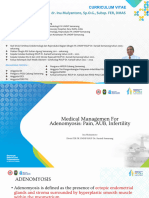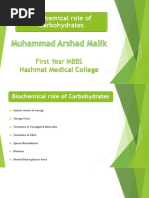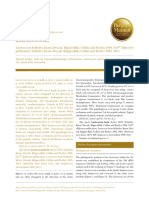0 ratings0% found this document useful (0 votes)
11 viewsUpl 05
Uploaded by
babekayyasaCopyright
© © All Rights Reserved
Available Formats
Download as DOCX, PDF, TXT or read online on Scribd
0 ratings0% found this document useful (0 votes)
11 viewsUpl 05
Uploaded by
babekayyasaCopyright
© © All Rights Reserved
Available Formats
Download as DOCX, PDF, TXT or read online on Scribd
You are on page 1/ 2
endometriosis is unclear. However, there are several widely accepted theories.
18 Overall, the CHCs
alleviate dysmenorrhea, a common symptom of endometriosis, reduce the growth of endometrial
tissue, decrease menstrual flow, and reduce prostaglandin generation. 18 They have also been
shown to down-regulate cell proliferation and increase apoptosis in the eutopic endometrium. 18
Secondary benefits of CHCs include menstrual cycle regulation and contraception. Oral CHCs have
demonstrated efficacy in a small number of observational, placebo-controlled and active-
comparator trials. The majority of studies on CHC efficacy have been for oral products; however, one
study demonstrated effectiveness of the CHC patch and vaginal ring, which may have appealing
dosing schedules compared to their oral counterparts. 19 The decision between CHCs should be
based upon patient preference, including adherence and cost. 2 The CHCs have traditionally been
dosed cyclically, with 3 weeks of active hormone followed by 1 week of placebo, allowing for a
withdrawal bleed. However, some individuals prefer the option to dose continuously, either through
commercially available “extended cycle” options or by skipping the placebo week of their CHC. A
prospective trial demonstrated that continuous dosing may be more efficacious than cyclic dosing
after individuals with recurrent postoperative dysmenorrhea were switched from cyclic to
continuous CHC dosing and reported a significant reduction in pain. 20 Other studies have mimicked
these results, and the ESHRE guidelines now specifically recommend continuous dosing as an option
for patients. 12 Due to the proposed estrogen dependency of endometriotic lesions, it has been
proposed that the estrogen dose in CHCs should be limited to avoid feeding the endometriosis
tissue. Even the lowest doses of commercially available CHCs are four to six times the physiologic
dose of estrogen; therefore, clinicians should consider initiating patients on CHCs with the lowest
effective estrogen dose to limit this possibility. Progestins Progestins are another first-line option for
suppression of endometriosis due to their efficacy in treating dysmenorrhea, the overall tolerability
of progestins, and their reasonable price. Progestins suppress growth of endometriotic implants,
eventually causing endometriotic atrophy. They have also demonstrated inhibition of blood vessel
growth and anti-inflammatory action, in addition to their anovulatory effects, all which relieve the
dysmenorrhea associated with endometriosis. 21–23 Progestins may be administered orally
(norethindrone acetate or medroxyprogesterone acetate), intramuscularly or subcutaneously (depot
medroxyprogesterone acetate–DMPA) or as a levonorgestrel intrauterine system (LNG-IUS). As with
other endometriosis treatment options, studies comparing progestin options directly are limited;
therefore, selection should account for the individual’s opinion about dosage form, as well as cost
and potential side effects and risks. 24 Oral Progestins Oral progestins are widely available as
contraceptive and menopausal hormonal replacement products. Importantly, contraceptive
progestin products have the added benefit of preventing pregnancy and managing other menstrual-
related side effects, such as acne. Injectable Depot Medroxyprogesterone Acetate The downsides to
injectable DMPA use include a slow return to fertility and potential bone mineral density loss, as
DMPA carries a black box warning to avoid use for greater than 2 years due to the risk of potentially
irreversible BMD loss. Controversy exists on the potential irreversibility of BMD loss and despite this
labeling, the ACOG has stated that clinicians may continue its use beyond 2 years in patients who are
responding well. 25 For those who wish to become pregnant shortly after discontinuing treatment,
this option may not be preferred because of its associated slow return of normal ovulation. Overall,
DMPA has a mean conception time of 10 months after discontinuation, compared to other hormonal
products that have shorter return to fertility. 26 Levonorgestrel Intrauterine System Insertion of an
LNG-IUS is an option for those seeking long-acting reversible contraceptive benefits in addition to
endometriosis pain relief. There are various forms of LNG-IUSs available in the market.
Approximately 20% to 30% of women experience amenorrhea within the first year of using an LNG-
IUS, reducing the major symptom of endometriosis, dysmenorrhea. 27 Despite their efficacy at
reducing endometriosis-related pain, no LNG-IUSs are currently Food and Drug Administration (FDA)
approved for the treatment of endometriosis. The LNG-IUDs do not inhibit ovulation, yielding a
potential for the growth of ovarian endometriomas. Other disadvantages of the LNG-IUS include
potential difficulty of inserting the device into nulliparous women, a 5% expulsion rate, and cost of
the procedure. 15 Alternative Drug Treatments Other options for treatment of endometriosis pain
include gonadotropinreleasing hormone (GnRH) agonists, GnRH antagonists, danazol, and aromatase
inhibitors. 2,12,15,28 Treatments fall into this category for several reasons: lack of data supporting
their efficacy in treating endometriosis, proven efficacy but intolerable adverse events, or unknown
long-term safety. None of these methods is proven superior over others, so treatment decisions
should be made based on patient preference of dosage form and dosing schedule, patient-specific
response, potential side effects, and medication costs/insurance coverage. 2,10,12,15 Several of the
options in this category can be combined with other medications to limit their adverse events. For
example, GnRH agonists are used with estrogen-progestin products to limit anti-estrogenic side
effects and aromatase inhibitors are prescribed with CHCs, progestins, or GnRH agonists.
Gonadotropin-Releasing Hormone Agonists The GnRH agonists are highly effective at treating
endometriosis-associated pain, but their use is limited by side effects and cost. The ACOG guidelines
recommend their empiric use in the event of NSAID or contraceptive failure. 2 Pharmacologically the
GnRH agonists inhibit follicle-stimulating hormone (FSH) and luteinizing hormone (LH) secretion,
which effectively mimics an oophorectomy. The GnRH agonists create a gonadotropic flare prior to
their long-term receptor downregulation, which may increase pain during this period. This can be
minimized by initiating therapy during the mid-luteal phase or overlapping therapy with a CHC or
progestin for three weeks. Pain will recur quickly upon discontinuation, making GnRH agonists a
chronic treatment option. 29,30 Although GnRH agonist are approved by the FDA currently for only
12-month courses of treatment, if a patient responds well to therapy it is often continued for longer
with add-back therapy (subsequently discussed). 2 Side effects seen with GnRH agonists are the
result of the hypoestrogenic environment and include BMD loss and vasomotor symptoms, such as
hot flushes, vaginal dryness, and insomnia. With long-term use (>6 months) BMD loss becomes a
major concern. Utilization of add-back therapy minimizes this loss and other adverse events and has
demonstrated safety for up to 10 years. 31,32 It is recommended to start add-back therapy on
immediate initiation of GnRH agonist treatment. 2,12,15 Monitoring for this class of medications
includes physical findings, bone density, and serum lipids. 2 Add-Back Therapy Add-back regimens
may consist of progestins alone, estrogens, and progestins and bisphosphonates and are utilized in
combination with GnRH agonists to reduce or eliminate BMD loss and provide symptomatic relief
against the anti-estrogenic effects of GnRH agonists. Several studies have recently shown that
estrogen-progestin combinations are more effective than progestin monotherapy at protecting for
BMD loss. 30,33,34 Adding estrogen to a GnRH agonist has a potential to negate its antiestrogenic
effects that relieve endometriosis pain. Therefore, the dose of estrogen must be low enough to
maintain a serum estrogen level
You might also like
- Associate Professor:Ivan Bonet. Obstetric and Gynecology Associate Professor:Ivan Bonet. Obstetric and Gynecology0% (1)Associate Professor:Ivan Bonet. Obstetric and Gynecology Associate Professor:Ivan Bonet. Obstetric and Gynecology31 pages
- Grandi 2019. Hormonal Contraception in Women With Endometriosis - A Systematic ReviewNo ratings yetGrandi 2019. Hormonal Contraception in Women With Endometriosis - A Systematic Review11 pages
- Use of Dienogest in Endometriosis: A Narrative Literature Review and Expert CommentaryNo ratings yetUse of Dienogest in Endometriosis: A Narrative Literature Review and Expert Commentary13 pages
- Evaluation of Long Term Efficacy and Safety of Dienogest in Patients With Chronic Cyclic Pelvic Pain Associated With EndometriosisNo ratings yetEvaluation of Long Term Efficacy and Safety of Dienogest in Patients With Chronic Cyclic Pelvic Pain Associated With Endometriosis9 pages
- Olive, D. L., & Pritts, E. A. (2001) - Treatment of Endometriosis. The New England Journal of Medicine, 345 (4), 266-275.No ratings yetOlive, D. L., & Pritts, E. A. (2001) - Treatment of Endometriosis. The New England Journal of Medicine, 345 (4), 266-275.11 pages
- Efficacy and Safety of Long Term Treatment in EndometriosisNo ratings yetEfficacy and Safety of Long Term Treatment in Endometriosis7 pages
- Medical Treatment of Endometriosis: Review ArticleNo ratings yetMedical Treatment of Endometriosis: Review Article10 pages
- Medical Treatment of Endometriosis-Related PainNo ratings yetMedical Treatment of Endometriosis-Related Pain24 pages
- Study of Dienogest For Dysmenorrhea and Pelvic Pain Associated With EndometriosisNo ratings yetStudy of Dienogest For Dysmenorrhea and Pelvic Pain Associated With Endometriosis6 pages
- Endometriosis and Adenomyosis: Bahaa MaliNo ratings yetEndometriosis and Adenomyosis: Bahaa Mali40 pages
- Use of Aromatase Inhibitors To Treat Endometriosis-Related Pain Symptoms: A Systematic ReviewNo ratings yetUse of Aromatase Inhibitors To Treat Endometriosis-Related Pain Symptoms: A Systematic Review10 pages
- Dienogest- Role in the Treatment of Endometriosis.No ratings yetDienogest- Role in the Treatment of Endometriosis.66 pages
- Information For Women With EndometriosisNo ratings yetInformation For Women With Endometriosis45 pages
- Drug Delivery For Treatment of EndometriosisNo ratings yetDrug Delivery For Treatment of Endometriosis11 pages
- Induction and Maintenance of Amenorrhea in Transmasculine and Nonbinary AdolescentsNo ratings yetInduction and Maintenance of Amenorrhea in Transmasculine and Nonbinary Adolescents6 pages
- Quality of Life and Sexual Function of Women Affected by Endometriosis Associated Pelvic Pain When Treated With DienogestNo ratings yetQuality of Life and Sexual Function of Women Affected by Endometriosis Associated Pelvic Pain When Treated With Dienogest8 pages
- ESHRE ENDOMETRIOSIS Patient Guideline - 21032022No ratings yetESHRE ENDOMETRIOSIS Patient Guideline - 2103202222 pages
- Information For Women With EndometriosisNo ratings yetInformation For Women With Endometriosis45 pages
- ACOG Updates Guideline On Diagnosis and TreatmentNo ratings yetACOG Updates Guideline On Diagnosis and Treatment2 pages
- Endometriosis: David Blair Toub, M.D. Department of Obstetrics and Gynecology Pennsylvania HospitalNo ratings yetEndometriosis: David Blair Toub, M.D. Department of Obstetrics and Gynecology Pennsylvania Hospital18 pages
- PEMATERI 11 - Medical Managemen For Adenomyosis - Pain, AUB, InfertilityNo ratings yetPEMATERI 11 - Medical Managemen For Adenomyosis - Pain, AUB, Infertility34 pages
- Evaluate The Effectiveness of Structured Teaching Program Regarding Menopausal Syndrome Among The Peri Menopausal Women in Bandarulanka, Amalapuram, Andhra PradeshNo ratings yetEvaluate The Effectiveness of Structured Teaching Program Regarding Menopausal Syndrome Among The Peri Menopausal Women in Bandarulanka, Amalapuram, Andhra Pradesh9 pages
- Understanding Pharmacology Essentials for Medication Safety M. Linda Workman - The ebook in PDF and DOCX formats is ready for download now100% (2)Understanding Pharmacology Essentials for Medication Safety M. Linda Workman - The ebook in PDF and DOCX formats is ready for download now36 pages
- Introduction To Clinical Biochemistry: Unikl Mestech (Clinical Labortory Science Section)No ratings yetIntroduction To Clinical Biochemistry: Unikl Mestech (Clinical Labortory Science Section)28 pages
- Sansulin R Suspensi Injeksi 100 IU, ML - Rekombinan Insulin Manusia - DKI0708100443A1 - 2016No ratings yetSansulin R Suspensi Injeksi 100 IU, ML - Rekombinan Insulin Manusia - DKI0708100443A1 - 20162 pages
- Management and Medications in Thyroid Strom and Myxoedema ComaNo ratings yetManagement and Medications in Thyroid Strom and Myxoedema Coma41 pages
- Anglais - College Prive Montesquieu - Sequence 3 - Annee Scolaire 2020 - 2021 - Classe de 6ème CamerounNo ratings yetAnglais - College Prive Montesquieu - Sequence 3 - Annee Scolaire 2020 - 2021 - Classe de 6ème Cameroun3 pages
- Bergey S Manual of Systematics of Archaea and Bacteria - 2015 - Teuber - LactococcusNo ratings yetBergey S Manual of Systematics of Archaea and Bacteria - 2015 - Teuber - Lactococcus21 pages
- Fenichel’s Clinical Pediatric Neurology (2019)cNo ratings yetFenichel’s Clinical Pediatric Neurology (2019)c373 pages

































































































